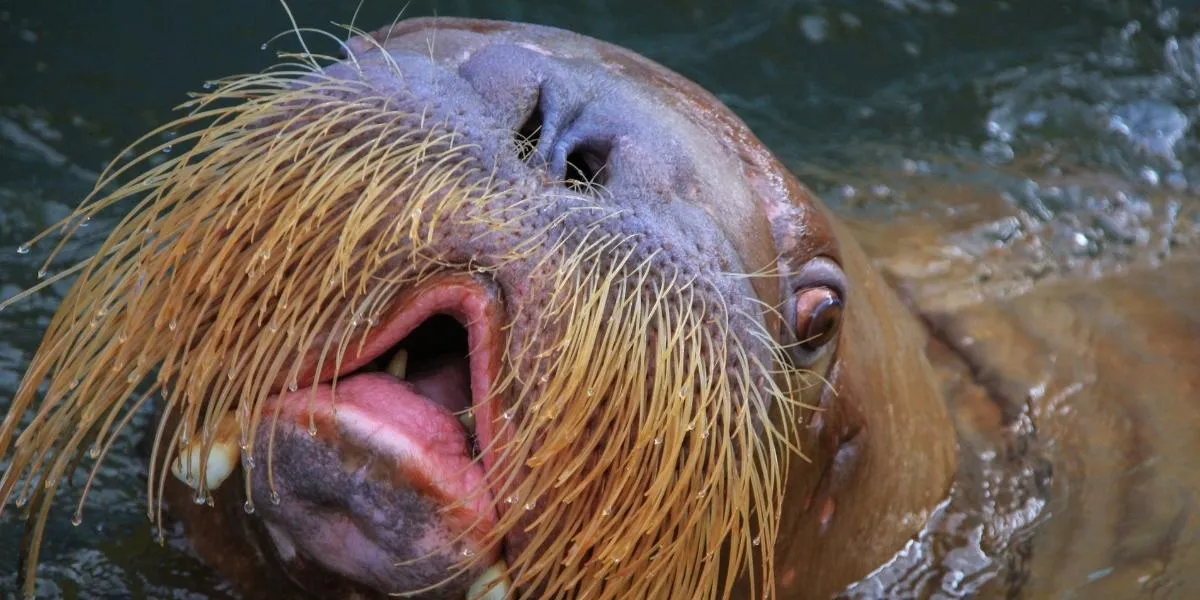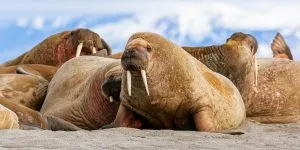Walruses are iconic marine mammals and are distinguished because of their large size, long tusks, and whiskers. It is also their whiskers that give off the characteristic of having a mustache. Why do walruses have these features, and do they do more than look like facial hair?
Both subspecies of walruses have whiskers and a mustache. These bristles are sensory organs called vibrissae. Vibrissae are used to detect vibrations within the water and discriminate object size, shape, and texture. However, the position of the vibrissae on the snout can determine its use.
Keep reading to find out more about what vibrissae are used for, and why their facial hair is important for their survival.
Why Do Walruses Have Whiskers?
Walruses have some of the most sensitive whiskers of all mammals1 (source: R. Grant, et al, Proceedings of Measuring Behavior, p.428, 2018). The scientific word for whiskers is vibrissae. A walruses vibrissae are connected to nerves, supplied with blood, and attached to muscles.
The whiskers are found on the walrus’s snout and are separated into around 13 to 15 rows. In total, each walrus has around 400 to 700 vibrissae. Each whisker is known to reach 12 inches (30cm) in length2 (sources: R.A. Kastelein and M.A. Van Gaalen, Aquatic Mammals, Vol. 14, No. 3, pp.123-133, 1988 and Seaworld). However, due to the regular use of the whiskers, it is common for them to be shorter due to being worn down3 (source: R.A. Kastelein and M.A. Van Gaalen, Aquatic Mammals, Vol. 14, No. 3, pp.123-133, 1988).
Walruses use their whiskers to detect vibrations within the water4 (source: R.A. Kastelein, Encyclopedia of Marine Mammals (2nd ed), pp.1212-1217, 2009). They play a particularly important role in marine mammals which forage in deep water5 (source: Wikipedia). Although walruses can dive quite deep, they prefer to hunt at depths of around 30 to 40 meters6 (source: F.H. Fay and J.J. Burns,Arctic, Vol. 41 No. 3, pp.167–259, 1988) as this is where their preferred prey can be found.
This means that this is their specialized sensory system, which allows them to detect prey within the water. Whiskers are also used to help identify objects, including their size, shape, and texture7 (source: R. Grant, et al, Proceedings of Measuring Behavior, p.428, 2018). However, it is these whiskers that help them detect objects; it is their mustaches that identify them8 (source: R.A. Kastelein and M.A. Van Gaalen, Aquatic Mammals, Vol. 16, No. 2, pp.78-87, 1990).
Why Do Walruses Have Moustaches?
Walruses appear to have a mustache because some of their vibrissae (or whiskers) are found in the center of their snout, above their top lip. Unlike a human mustache, which serves the purpose of attracting females and being seen as dominant9 (source: BBC), a walruses mustache is used to sense their surroundings.
The vibrissae found in the center of the snout have been recorded to have the highest sensitivity. This area is used for discriminating between shapes. This is particularly the case for vibrissae found above the top lip – their mustache10 (source: R.A. Kastelein and M.A. Van Gaalen, Aquatic Mammals, Vol. 14, No. 3, pp.123-133, 1988).
Their mustache helps the walrus to forage for prey, as they are able to differentiate between prey and irrelevant objects – such as stones. This is particularly useful because their prey is usually found in murky water, in or above the substrate11 (source: R.A. Kastelein and M.A. Van Gaalen, Aquatic Mammals, Vol. 16, No. 2, pp.78-87, 1990).
Our dedicated article with 16 facts about walruses is a great place to find out more interesting information about these mustache-wearing mammals.
Related Questions
Why Do Walruses Have Tusks?
Both male and female walruses have enlarged canine teeth, referred to as tusks12 (source: WWF). Walrus use their tusks to fight other walrus or predators, protect their calves and keep breathing holes open in the ice.
Walruses also use their tusks when they want to hauls out – this is when they leave the sea to rest on ice or landmass. Walrus do not use their teeth to hunt for, or eat, prey13 (sources: WWF and R.A. Kastelein and M.A. Van Gaalen, Aquatic Mammals, Vol. 14, No. 3, pp.123-133, 1988).



![Read more about the article Why Do Walruses Have Tusks? [Everything You Need To Know]](https://polarguidebook.com/wp-content/uploads/2022/06/Why-do-walruses-have-tusks-300x150.jpg)

